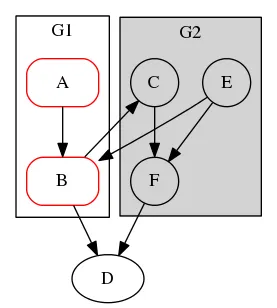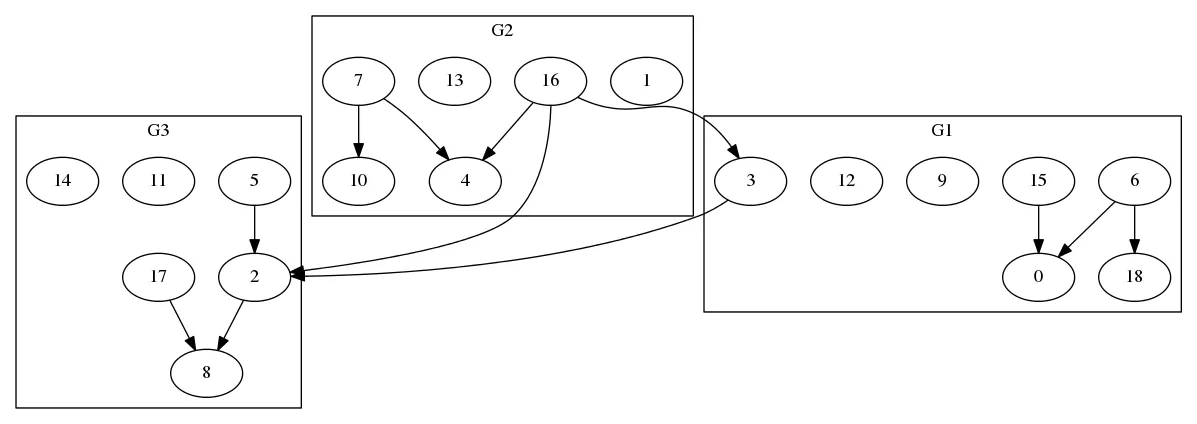可以使用::boost::write_graphviz生成DOT子图吗?
例如,如果我在图形G中创建了一个子图G0,是否可以在DOT输出中获得以下内容:
graph G {
subgraph G0 {
...
}
...
}
可以使用::boost::write_graphviz生成DOT子图吗?
例如,如果我在图形G中创建了一个子图G0,是否可以在DOT输出中获得以下内容:
graph G {
subgraph G0 {
...
}
...
}
我终于弄清了子图是如何工作的,以及如何使用boost::write_graphviz来打印这些子图。
第一个要求在boost库源代码的注释中“半文档化”地说明:requires graph_name property。
然而,最令人惊讶的要求似乎是detail::write_graphviz_subgraph假定存在以下属性:
vertex_attributeedge_attributegraph_vertex_attribute、graph_edge_attribute、graph_graph_attribute图形属性我认为这些要求可能相当严格,因为您的图类型至少看起来像这样:
using Graph =
adjacency_list<vecS, vecS, directedS,
property<vertex_attribute_t, GraphvizAttributes>,
property<edge_index_t, int, property<edge_attribute_t, GraphvizAttributes> >,
property<graph_name_t, std::string,
property<graph_graph_attribute_t, GraphvizAttributes,
property<graph_vertex_attribute_t, GraphvizAttributes,
property<graph_edge_attribute_t, GraphvizAttributes>
> > >
>;
无论如何,演示如何向Graphviz提供边/节点/(子)图属性当然很好:
template <typename SubGraph> SubGraph create_data()
{
enum { A,B,C,D,E,F,N }; // main edges
SubGraph main(N);
SubGraph& sub1 = main.create_subgraph();
SubGraph& sub2 = main.create_subgraph();
auto A1 = add_vertex(A, sub1);
auto B1 = add_vertex(B, sub1);
auto E2 = add_vertex(E, sub2);
auto C2 = add_vertex(C, sub2);
auto F2 = add_vertex(F, sub2);
add_edge(A1, B1, sub1);
add_edge(E2, F2, sub2);
add_edge(C2, F2, sub2);
add_edge(E, B, main);
add_edge(B, C, main);
add_edge(B, D, main);
add_edge(F, D, main);
// setting some graph viz attributes
get_property(main, graph_name) = "G0";
get_property(sub1, graph_name) = "clusterG1";
get_property(sub2, graph_name) = "clusterG2";
get_property(sub1, graph_graph_attribute)["label"] = "G1";
/*extra*/get_property(sub1, graph_vertex_attribute)["shape"] = "Mrecord";
get_property(sub2, graph_graph_attribute)["label"] = "G2";
/*extra*/get_property(sub1, graph_vertex_attribute)["color"] = "red";
/*extra*/get_property(sub2, graph_graph_attribute)["fillcolor"] = "lightgray";
/*extra*/get_property(sub2, graph_graph_attribute)["style"] = "filled";
/*extra*/get_property(sub2, graph_vertex_attribute)["shape"] = "circle";
return main;
}

那就是这个样子:
int main() {
#ifdef GENERATE_RANDOM_GRAPHS
auto g = generate_random<subgraph<Graph> >();
#else
auto g = create_data<subgraph<Graph> >();
#endif
for (auto vd : make_iterator_range(vertices(g))) {
put(get(vertex_attribute, g), vd,
GraphvizAttributes{
{"label", name_for_index(vd)}
});
}
write_graphviz(std::cout, g);
}
我还为了自己的测试和理解,实现了generate_random函数。它生成类似下面的图表:

#include <boost/graph/graphviz.hpp>
#include <boost/graph/adjacency_list.hpp>
#include <boost/graph/subgraph.hpp>
#include <iostream>
using namespace boost;
//#define GENERATE_RANDOM_GRAPHS
#ifdef GENERATE_RANDOM_GRAPHS
#include <boost/graph/random.hpp> // in case you comment out the random graph creation code
#include <random>
template <typename SubGraph> SubGraph generate_random()
{
std::mt19937 prng(std::random_device{}());
SubGraph randomized(uniform_int<int>(10,20)(prng));
auto subs = uniform_int<int>(1,5)(prng);
while (subs--) randomized.create_subgraph();
subs = boost::size(randomized.children());
int offset = 0;
for (auto& sub : make_iterator_range(randomized.children()))
{
for (size_t i = offset; i < num_vertices(randomized); i += subs)
add_vertex(i, sub);
++offset;
}
auto random_edges = [&](SubGraph& g) {
uniform_int<typename SubGraph::vertex_descriptor> v(0, num_vertices(g) -1);
for (size_t i = 1; i < 4; ++i)
add_edge(v(prng), v(prng), g);
};
for (auto& sub : make_iterator_range(randomized.children()))
random_edges(sub);
random_edges(randomized);
// setting some graph viz attributes
get_property(randomized, graph_name) = "G0";
offset = 0;
for (auto& sub : make_iterator_range(randomized.children())) {
++offset;
get_property(sub, graph_name) = "cluster" + std::to_string(offset);
get_property(sub, graph_graph_attribute)["label"] = "G" + std::to_string(offset);
}
return randomized;
}
#else
template <typename SubGraph> SubGraph create_data()
{
enum { A,B,C,D,E,F,N }; // main edges
SubGraph main(N);
SubGraph& sub1 = main.create_subgraph();
SubGraph& sub2 = main.create_subgraph();
auto A1 = add_vertex(A, sub1);
auto B1 = add_vertex(B, sub1);
auto E2 = add_vertex(E, sub2);
auto C2 = add_vertex(C, sub2);
auto F2 = add_vertex(F, sub2);
add_edge(A1, B1, sub1);
add_edge(E2, F2, sub2);
add_edge(C2, F2, sub2);
add_edge(E, B, main);
add_edge(B, C, main);
add_edge(B, D, main);
add_edge(F, D, main);
// setting some graph viz attributes
get_property(main, graph_name) = "G0";
get_property(sub1, graph_name) = "clusterG1";
get_property(sub2, graph_name) = "clusterG2";
get_property(sub1, graph_graph_attribute)["label"] = "G1";
/*extra*/get_property(sub1, graph_vertex_attribute)["shape"] = "Mrecord";
get_property(sub2, graph_graph_attribute)["label"] = "G2";
/*extra*/get_property(sub1, graph_vertex_attribute)["color"] = "red";
/*extra*/get_property(sub2, graph_graph_attribute)["fillcolor"] = "lightgray";
/*extra*/get_property(sub2, graph_graph_attribute)["style"] = "filled";
/*extra*/get_property(sub2, graph_vertex_attribute)["shape"] = "circle";
return main;
}
#endif
using GraphvizAttributes =
std::map<std::string, std::string>;
using Graph =
adjacency_list<vecS, vecS, directedS,
property<vertex_attribute_t, GraphvizAttributes>,
property<edge_index_t, int, property<edge_attribute_t, GraphvizAttributes> >,
property<graph_name_t, std::string,
property<graph_graph_attribute_t, GraphvizAttributes,
property<graph_vertex_attribute_t, GraphvizAttributes,
property<graph_edge_attribute_t, GraphvizAttributes>
> > >
>;
static std::string name_for_index(intmax_t index) {
std::string name;
do {
name += 'A' + (index%26);
index /= 26;
} while (index);
return name;
}
int main() {
#ifdef GENERATE_RANDOM_GRAPHS
auto g = generate_random<subgraph<Graph> >();
#else
auto g = create_data<subgraph<Graph> >();
#endif
for (auto vd : make_iterator_range(vertices(g))) {
put(get(vertex_attribute, g), vd,
GraphvizAttributes{
{"label", name_for_index(vd)}
});
}
write_graphviz(std::cout, g);
}
make_iterator_vertex_map(names)和subgraph<Graph>,至少在1.68.0版本中不行。请参见https://stackoverflow.com/q/54599136。 - LogicStuff
create_subgraph创建子图? - Mitchell Slep